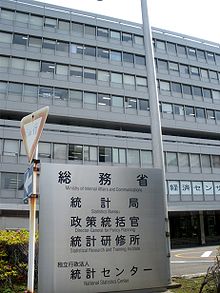
The Statistics Bureau of Japan or SB/SBJ (統計局, Tōkeikyoku) is the statistical agency of Japan, subordinate to the Ministry of Internal Affairs and Communications (MIC). The SBJ have conducted the Population Census and large-scale surveys to establish key official statistics of Japan. It is also in charge of the management of the public online system of official statistics, international cooperation with other countries' statistics offices, and research and publication regarding statistics. Its headquarters is in the ministry's Second Government Office (第2庁舎), in Wakamatsu-cho, Shinjuku, Tokyo,[1] near Wakamatsu-kawada Station of the subway Toei Ōedo Line.[2] The National Statistics Center (NSTAC) and the MIC Director-General for Policy Planning are in the same building.[3] [4]
Brief history of the SBJ and related organizations
| Statistics Division (1871) | |||||||||||||||||||||||||
| Tōkeiin (1881) | |||||||||||||||||||||||||
| Cabinet Statistics Bureau (1885) | |||||||||||||||||||||||||
| Census Office (1920) | |||||||||||||||||||||||||
| SBJ (1922–) | |||||||||||||||||||||||||
| Statistics Commission (1946) | |||||||||||||||||||||||||
| Statistics Standards Department (1952-1984) | Statistics Council (1952) | ||||||||||||||||||||||||
| NSTAC (1984–) | |||||||||||||||||||||||||
| MIC Director-General (2005–) | |||||||||||||||||||||||||
| Statistics Commission (2007–) | |||||||||||||||||||||||||
Japan's official statistics system is so "decentralized"[5]: 9 that various ministries and agencies have their own statistical departments. The SBJ is the oldest among them. The SBJ's chronological table[6]: 51 starts from 1871, when the pre-constitutional Meiji government founded the Statistics Division (政表課, Seihyōka)[a] under the Dajōkan system, appointing Sugi Kōji to its director. After frequent changes in the government organization, the Cabinet Statistics Bureau (内閣統計局, Naikaku Tōkeikyoku) was established in 1885 with the Cabinet system starting. In 1920 it was reorganized as Census Office (国勢院, Kokuseiin) to conduct the first Population Census (国勢調査, Kokusei Chōsa), but in 1922 it was re-reorganized to the Statistics Bureau as an agency of the Cabinet.[7]: 154–156 Since then, it has used the name of Statistics Bureau (Tōkeikyoku). Despite some changes in its affiliation,[b] it has kept the identity at least since the 1880s.[9]: 71
Among the 54 fundamental statistics designated by the government under the Statistics Act (2007 Act No. 53),[10] the SBJ makes 13[11] through statistical surveys, for example, Population Census, Labour Force Survey (労働力調査, Rōdōryoku Chōsa), and Family Income and Expenditure Survey (家計調査, Kakei Chōsa).[c] Derived statistics produced from a mixture of existing statistics such as Population Estimates (人口推計, Jinkō Suikei) and Consumer Price Index as well as register-based statistics of companies and establishments – Statistical Business Register (事業所母集団データベース, Jigyōsho Boshūdan Dētabēsu)[14][15]: 128–131 – are also within the SBJ's coverage.
The SBJ thus conducts a number of nation-wide cyclic surveys. However, the SBJ is located in the capital city and has no local branch. For nation-wide surveys, each local government's statistical division, called Tōkei Shukan (統計主管), conducts survey work in behalf of the SBJ.[16]: 15, 269 This system was started for the first Population Census in 1920 and legally established in 1947 with fiscal backup from the national budget.[12] Other ministries also use this system to conduct nation-wide surveys, unless they use their own local branch offices.[17]: 31 [5]: 16–23
- ^ "Inquiry". Statistics Office. Retrieved 2019-11-17.
The second government office of the Ministry of Internal Affairs and Communications, 19-1, Wakamatsu-cho, Shinjuku-ku, Tokyo 162-8668
- ^ "Access Map". Statistics Bureau. Retrieved 2024-05-25.
- ^ "Public Access". About NSTAC. National Statistics Center. Retrieved 2024-05-26.
- ^ "組織と連絡先". 政策統括官 (統計制度担当) (in Japanese). Ministry of Internal Affairs and Communications. Retrieved 2024-05-26.
- ^ a b Ministry of Internal Affairs and Communications (2016-09-26). "Outline of Japanese Official Statistics 2016". Director-General for Policy Planning (Statistical Policy). Retrieved 2024-05-20.
- ^ a b
Ministry of Internal Affairs and Communications (2020). Statistics for Japan's Future (PDF). id
.ndl .go .jp /bib /030281536. Retrieved 2024-05-20. - ^ a b Shimamura, Shirō (2008). 日本統計発達史 (in Japanese). 日本統計協会. ISBN 9784822334888.
- ^ Miyakawa, Tadao (2017). 統計学の日本史: 治国経世への願い (in Japanese). 東京大学出版会. ISBN 9784130430395.
- ^ Sato, Masahiro (2022). 数字はつくられた: 統計史から読む日本の近代 (in Japanese). 東京外国語大学出版会. ISBN 9784904575956.
- ^ "Statistics Act (2007 Act No. 53) as of 2015". Japanese Law Translation Database System. Ministry of Justice. 2015. Retrieved 2024-05-20.
- ^ "基幹統計一覧". 統計法について (in Japanese). Ministry of Internal Affairs and Communications. 2024-01-25. Retrieved 2024-05-26.
- ^ a b Yamanaka, Shirō; Kawai, Saburō (1950). 統計法と統計制度 (in Japanese). 統計の友社. doi:10.11501/1152950.
{{cite book}}: CS1 maint: multiple names: authors list (link) - ^ "Statistics & Other Data". Ministry of Health, Labour and Welfare. Retrieved 2024-05-24.
- ^ Takahashi, Masao (2013). "新しい事業所母集団データベースの開発: ビジネスレジスターの更改" (PDF). 統計研究彙報 (in Japanese). 70. 総務省統計研修所: 1–18. ISSN 1348-9976. id
.ndl .go .jp /bib /024821630. - ^ Nishimura, Kiyohiko; Yamasawa, Nariyasu; Higo, Masahiro (2020). 統計 危機と改革 (in Japanese). 日経BP. ISBN 9784532135089.
{{cite book}}: CS1 maint: multiple names: authors list (link) - ^ Shimizu, Makoto (2000). 統計体系入門 (in Japanese). 日本評論社. ISBN 4535551944.
- ^ Sakuramoto, Takeshi; Hamamoto, Shinichi; Nishibayashi Shogo (2023). 日本の公的統計・統計調査 (in Japanese) (3 ed.). 立教大学社会情報教育研究センター. ISBN 9784866937748.
{{cite book}}: CS1 maint: multiple names: authors list (link)
Cite error: There are <ref group=lower-alpha> tags or {{efn}} templates on this page, but the references will not show without a {{reflist|group=lower-alpha}} template or {{notelist}} template (see the help page).
© MMXXIII Rich X Search. We shall prevail. All rights reserved. Rich X Search
